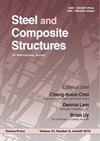Optimum location of second outrigger in RC core walls subjected toNF earthquakes
IF 3.9
3区 工程技术
Q1 CONSTRUCTION & BUILDING TECHNOLOGY
引用次数: 5
Abstract
Seismic responses of RC core wall with two outriggers are investigated in this study. In the models analyzed here, one of the outriggers is fixed at the top of the building and the second is placed at different levels along the height of the system. Each of the systems resulting from the placement of the outrigger at different locations is designed according to the prescriptive codes. The location of the outrigger changes along the height. Linear design of all the structures is accomplished by using prescriptive codes. Buckling restrained braces (BRBs) are used in the outriggers and forward directivity near fault and far fault earthquake record sets are used at maximum considered earthquake (MCE) level. Results from nonlinear time history analysis demonstrate that BRB outriggers can change the seismic responses like force distribution and deformation demand of the RC core-walls over the height and lead to the new plastic hinge arrangement over the core-wall height. Plasticity extension in the RC core wall occurs at the base as well as adjacent to the outrigger levels. Considering the maximum inter-story drift ratio (IDR) demand as an engineering parameter, the best location for the second outrigger is at 0.75H, in which the maximum IDR at the region upper the second outrigger level is approximately equal to the corresponding value in the lower region.地震作用下钢筋混凝土核心墙第二支腿的最佳位置
本文研究了带有两个伸出臂的RC核心墙的地震反应。在这里分析的模型中,一个支腿固定在建筑物的顶部,另一个支腿沿着系统的高度放置在不同的水平上。在不同位置放置支腿所产生的每个系统都是根据规范设计的。支腿的位置沿高度变化。所有结构的线性设计都是通过规范来完成的。外伸臂采用屈曲约束支撑(brb),最大考虑地震(MCE)级别采用近断层和远断层正向指向性地震记录集。非线性时程分析结果表明,BRB伸出臂可以改变RC核心墙在高度上的力分布和变形需求等地震反应,从而导致新的核心墙高度上的塑性铰布置。RC核心墙的塑性扩展发生在基础以及支腿水平附近。考虑最大层间漂移比(IDR)需求作为工程参数,第二支臂的最佳位置为0.75H,其中第二支臂上部区域的最大IDR近似等于下部区域的相应值。
本文章由计算机程序翻译,如有差异,请以英文原文为准。
求助全文
约1分钟内获得全文
求助全文
来源期刊

Steel and Composite Structures
工程技术-材料科学:复合
CiteScore
8.50
自引率
19.60%
发文量
0
审稿时长
7.5 months
期刊介绍:
Steel & Composite Structures, An International Journal, provides and excellent publication channel which reports the up-to-date research developments in the steel structures and steel-concrete composite structures, and FRP plated structures from the international steel community. The research results reported in this journal address all the aspects of theoretical and experimental research, including Buckling/Stability, Fatigue/Fracture, Fire Performance, Connections, Frames/Bridges, Plates/Shells, Composite Structural Components, Hybrid Structures, Fabrication/Maintenance, Design Codes, Dynamics/Vibrations, Nonferrous Metal Structures, Non-metalic plates, Analytical Methods.
The Journal specially wishes to bridge the gap between the theoretical developments and practical applications for the benefits of both academic researchers and practicing engineers. In this light, contributions from the practicing engineers are especially welcome.
 求助内容:
求助内容: 应助结果提醒方式:
应助结果提醒方式:


